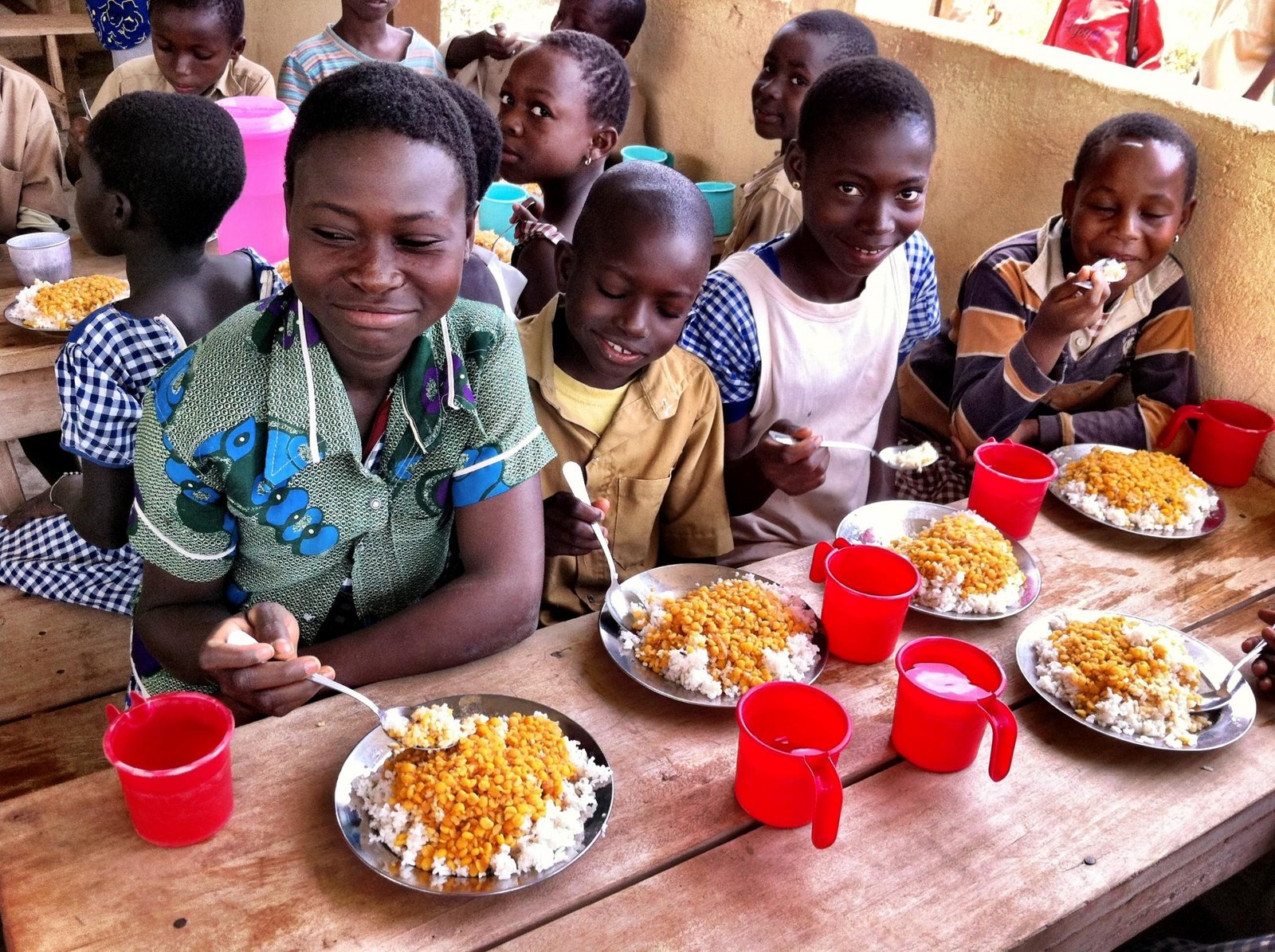Take Me to the Ivorian Recipes
Ivorian cuisine is a rich tapestry of flavors that mirrors the diverse culture and vibrant traditions of Côte d’Ivoire, a country located on the west coast of Africa.
Known for its tropical climate, Côte d’Ivoire is a land of lush landscapes ranging from golden beaches to dense rainforests, a testament to its scenic diversity. This West African nation nestles between Ghana, Liberia, Mali, Burkina Faso, and Guinea, and the waves of the Atlantic Ocean lap its southern coast. All of this guarantees an extensive and delicious cuisine!
The country’s main industrial activity revolves around agriculture, with cocoa production being particularly notable, making it the world’s largest exporter. With a population of about 26 million people, Ivorian society is a melting pot of ethnicities, each contributing to the nation’s gastronomic heritage.
Ivorian Cuisine – Key Takeaways
- Ivorian cuisine uses fresh, local ingredients like yams, plantains, and seafood.
- Staple dishes such as Fufu, Attiéké, and Kedjenou reflect the country’s agricultural wealth and culinary creativity.
- The history of Côte d’Ivoire, including its colonial past, has influenced the fusion found in Ivorian cuisine.
- Geographical diversity from beaches to forests impacts the availability of ingredients, shaping regional dishes.
- Ivorian meals are typically communal, showcasing the nation’s emphasis on sharing and hospitality.
- Street food is an integral part of Ivorian cuisine, offering a taste of local flavors to everyone.
Take Me to the Ivorian Recipes
You may also be interested in the following article
- North and South American Cuisine – A Culinary Expedition
- Europe Cuisine: Savor the Continent’s Best Culinary Secrets!
- African Cuisine: Discover the Bold Flavors & Global Charm!
- Asian Cuisine Unlock its Secrets – Taste, Health & Global Influence!
Where is the Ivory Coast

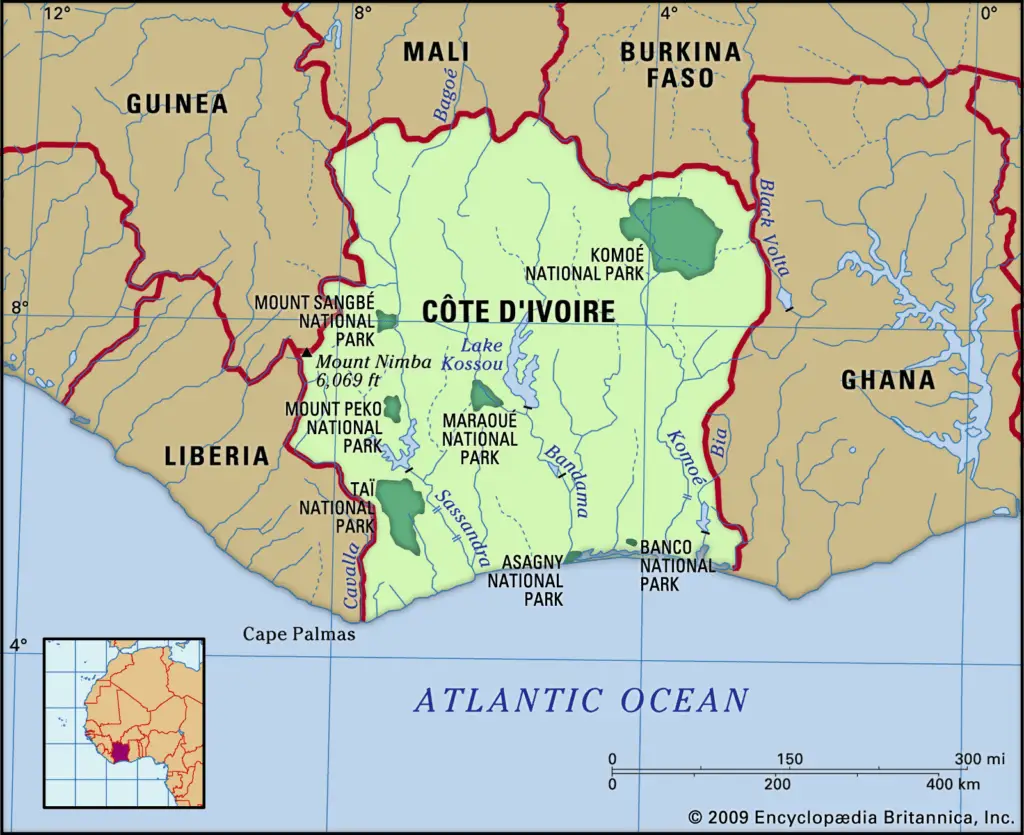
Index of Contents
- Take Me to the Ivorian Recipes
- The History and the Affect It Has Had on Ivorian Cuisine
- How Côte d’Ivoire’s Climate and Geography has Influenced Ivorian Cuisine
- Strange and Fun Facts About the Ivory Coast
- Understanding the Essence of Ivorian Cuisine
- How Healthy is Ivorian Food?
- Ivorian Culinary Traditions
- Exploring Côte d’Ivoire’s Ingredients: The Flavors of Ivorian Cuisine
- Great Recipes to Try at Home
- Conclusion
- FAQ’s
Savor iconic Ivorian Food Recipes – Click on each tantalizing picture to open up the Recipe

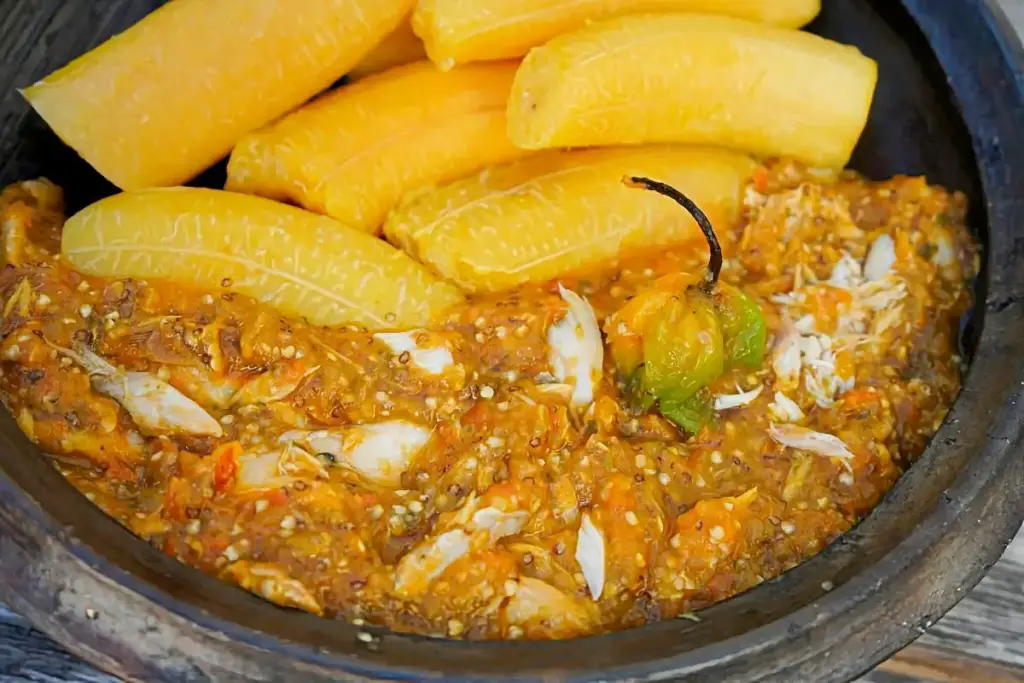




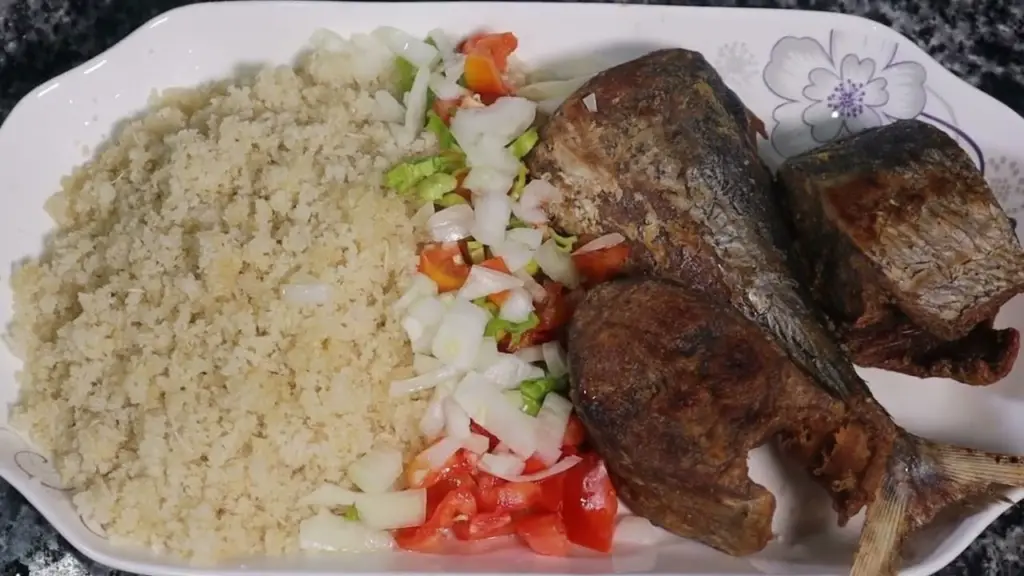


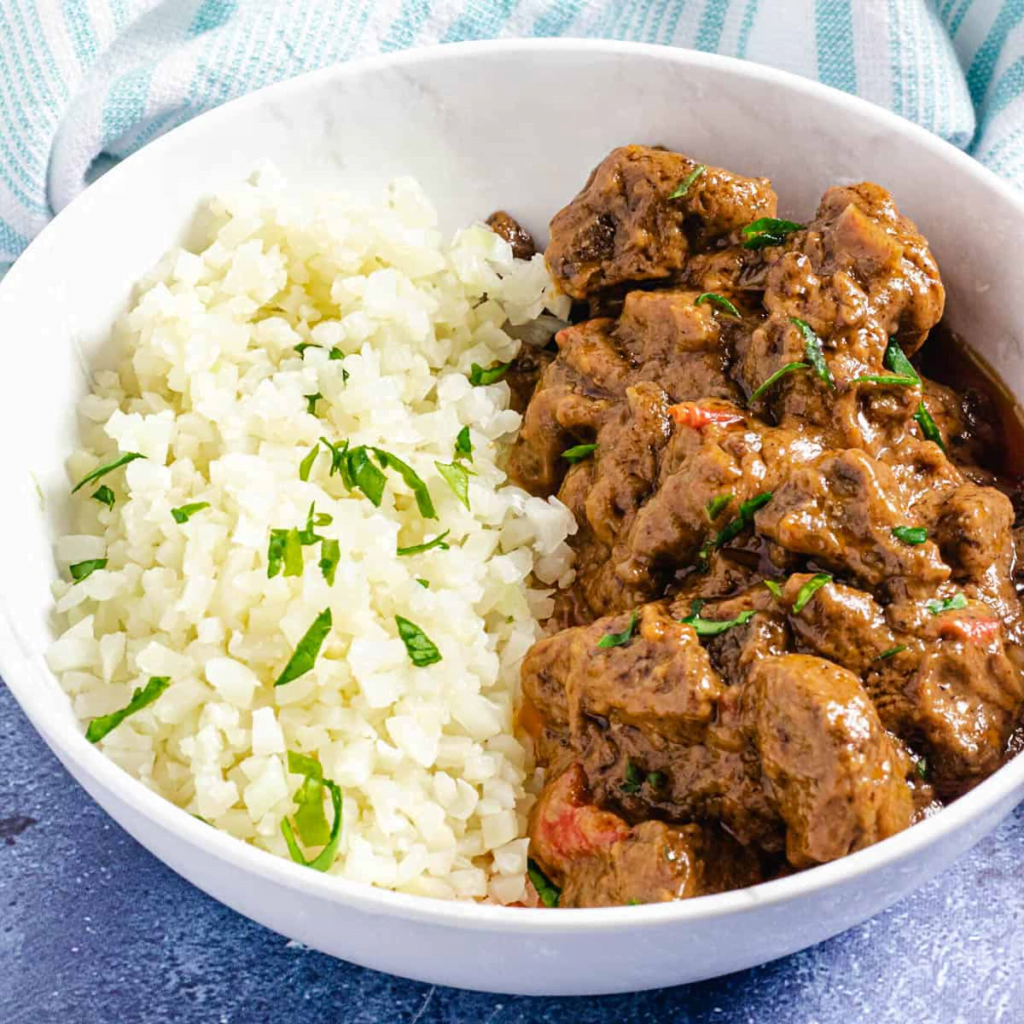
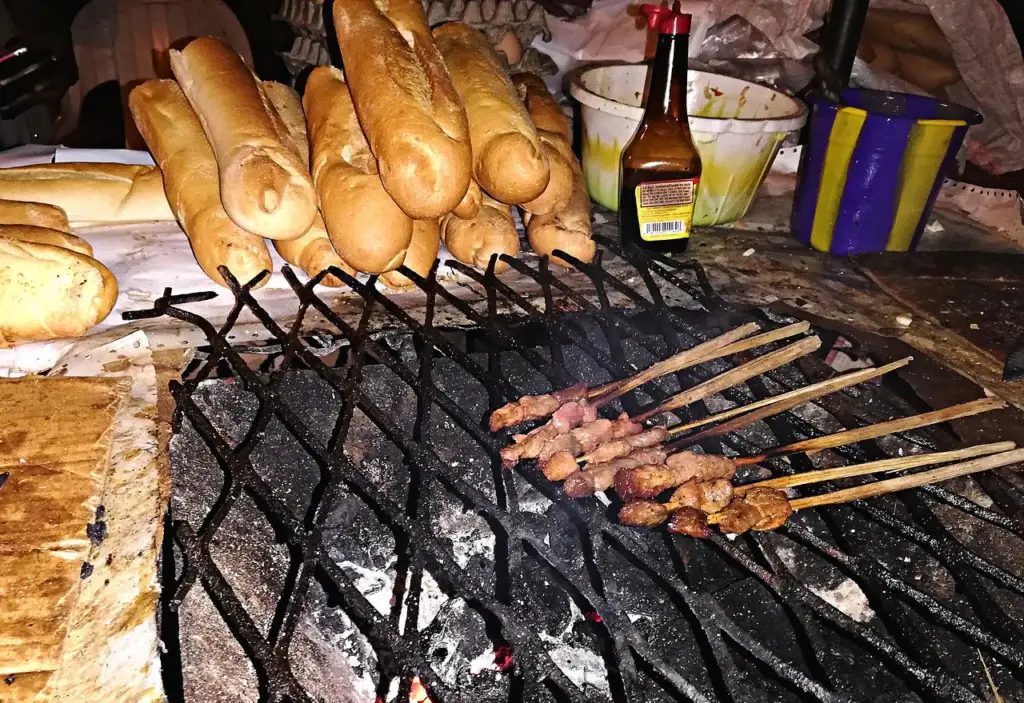

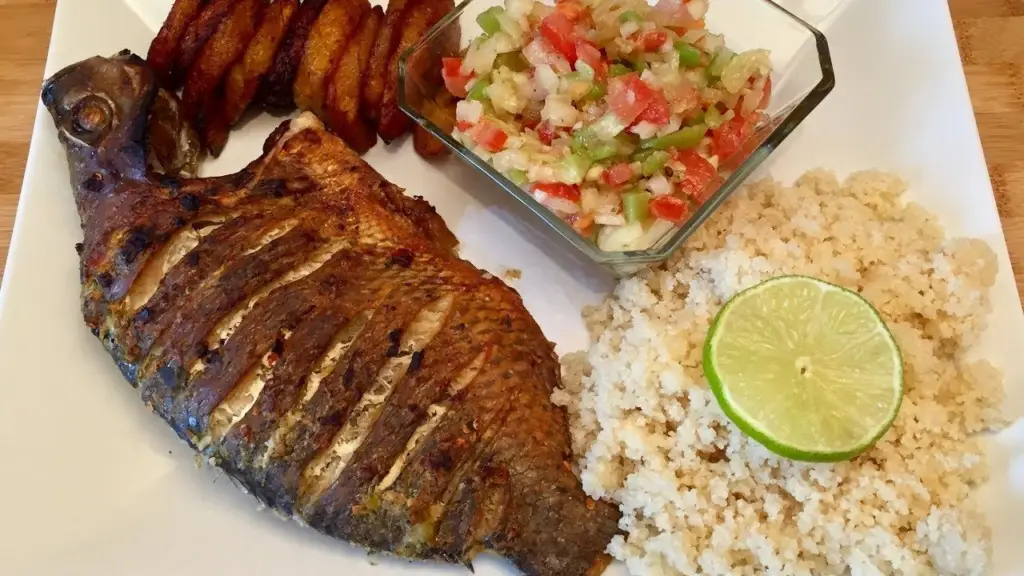



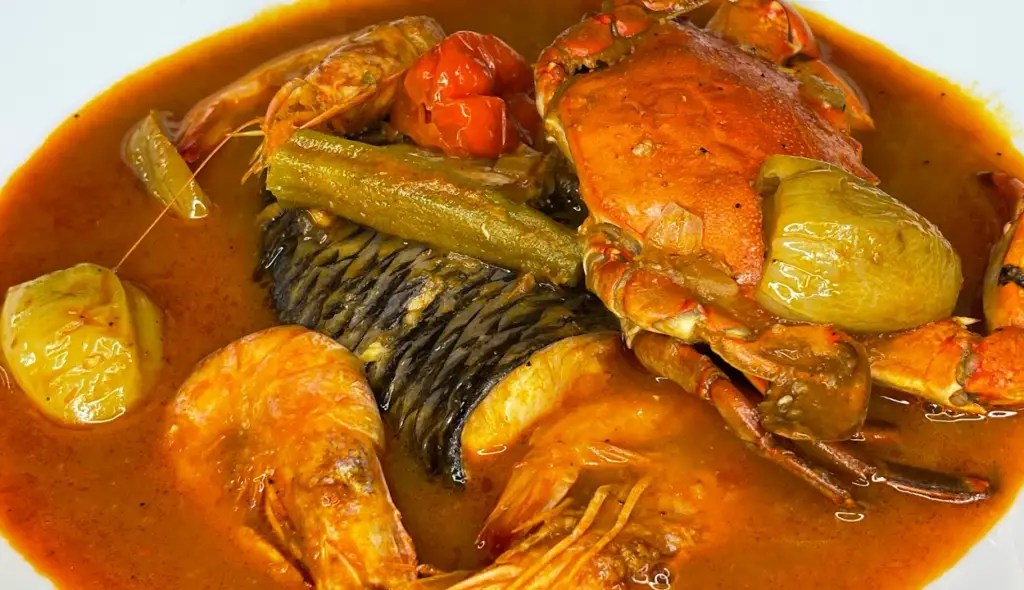




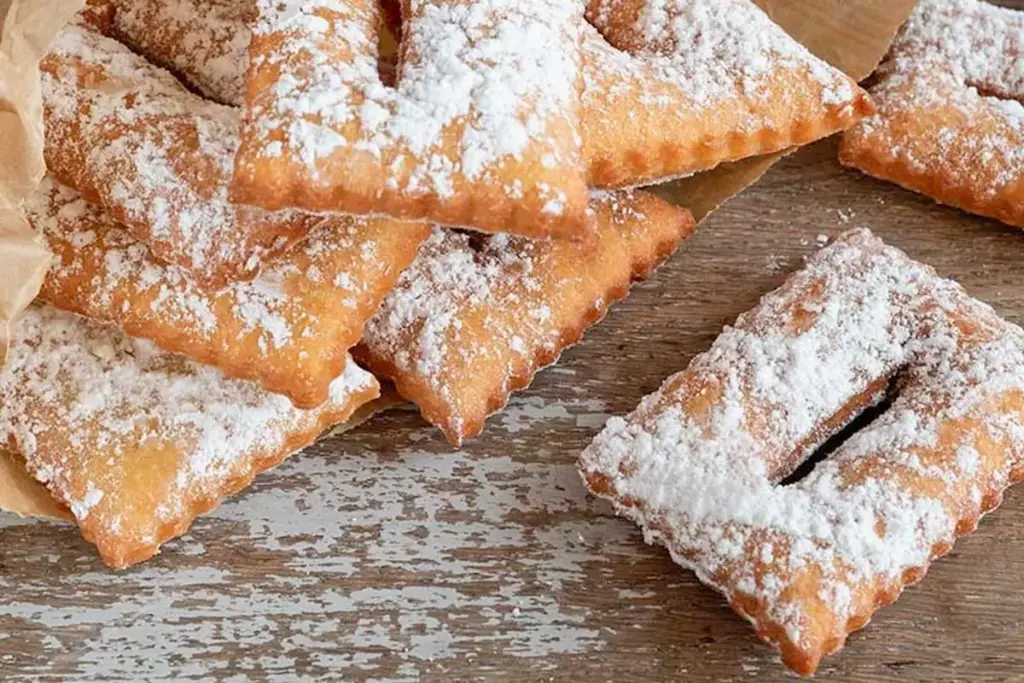
The History and the Affect It Has Had on Ivorian Cuisine
The history of the Ivory Coast, or Côte d’Ivoire, can be divided into four main periods: the pre-colonial, the colonial, the post-colonial, and the modern. Each period has had an impact on the cuisine of the country, as follows:
The Ivory Coast pre-colonial period

Before the arrival of the Europeans, the Ivory Coast was inhabited by various ethnic groups, such as the
- Akan
- The Mandé
- The Kru
- The Voltaic
They had different cultures and cuisines, but they shared some common foods, such as tubers, grains, plantains, beans, and palm oil.
The people also used local spices, such as ginger, garlic, and chili, to flavor their dishes. They cooked their food in clay pots or in earth ovens called hāngī.
Some of their traditional dishes include
- Attiéké (fermented cassava couscous)
- Foutou (pounded plantain or yam)
- Placali (fermented cassava dough)
The The Ivory Coast colonial period
The Ivory Coast was colonized by France in the late 19th century, and became part of the French West Africa federation. The French introduced new crops, such as potatoes, rice, wheat, coffee, cocoa, and cotton, and also imported foods, such as corned beef, mutton flaps, and canned goods.
They also influenced the cuisine of the country with their culinary traditions, such as bread, cheese, wine, and pastries.
The colonial period also created a racial and social divide between the French settlers and the native Ivorians, which affected their access to food and resources.
The Post-colonial Period
The Ivory Coast gained its independence from France in 1960, under the leadership of Félix Houphouët-Boigny, who ruled the country until 1993. The country experienced economic growth and stability, thanks to its exports of cocoa, coffee, and palm oil.
The cuisine of the country became more diverse and influenced by other cultures, such as American, Chinese, Indian, and Lebanese, as refugees and immigrants brought new dishes and flavors.
However, towards the ned of this period the country also faced political instability, coups, and civil wars, which disrupted the food security and availability of the people.
The Modern Period

Since the 2000s, the Ivory Coast has been recovering from the effects of the civil wars and trying to achieve peace and reconciliation. The country is still one of the world’s largest producers of cocoa, coffee, and palm oil, and also has a rich and varied cuisine that reflects its history, culture, and identity.
Some of the modern dishes of the country are garba (attiéké with fried tuna), alloco (fried plantain with chili and onion sauce), and kédjénou (spicy chicken stew cooked in a sealed pot)
References
How Côte d’Ivoire’s Climate and Geography has Influenced Ivorian Cuisine
Côte d’Ivoire’s climate and geography play a significant role in shaping the country’s cuisine, creating a rich culinary tapestry that reflects the diverse natural resources available. The country is located in West Africa, and its cuisine is influenced by the tropical climate, diverse landscapes, and abundant agricultural produce.
Here’s how the climate and geography have impacted Ivorian cuisine:
Côte d’Ivoire Climate
Côte d’Ivoire has a tropical climate with distinct wet and dry seasons. This climate fosters the growth of a variety of fruits, vegetables, and crops. The abundance of sunlight and warm temperatures throughout the year contributes to the availability of fresh, locally sourced ingredients.
The climate also influences the preferences for certain cooking methods and the types of dishes that are popular.
Côte d’Ivoire Geography
Coastal Influence
The country has a coastal region along the Gulf of Guinea, providing access to a variety of seafood. Coastal communities contribute to the Ivorian cuisine with dishes featuring fish, shrimp, and other seafood, often prepared with flavorful spices and herbs.
Savannah and Forested Areas
The central and northern parts of the country consist of savannahs and dense forests. These regions contribute to the availability of diverse flora and fauna, including wild game and a variety of fruits such as plantains, bananas, and pineapples.
Agricultural Diversity
Côte d’Ivoire is a major producer of cocoa, coffee, and palm oil. The fertile soil and favorable climate support the cultivation of these crops, influencing the inclusion of cocoa and coffee in local dishes and the use of palm oil in cooking.
The Impact on Ivorian Cuisine:
Common Ivorian Ingredients
- Cocoa and Coffee: These are integral to Ivorian cuisine, and cocoa is not only exported but also used in local recipes, creating a unique blend of sweet and savory flavors.
- Seafood: Coastal areas contribute to a variety of seafood dishes, including grilled fish, shrimp stews, and seafood soups.
- Tropical Fruits: The abundance of tropical fruits influences desserts, beverages, and side dishes. Fruits like plantains and pineapples are commonly used.
Ivorian Cooking Methods
- Grilling and Smoking: Due to the availability of open spaces and the influence of different communities, grilling and smoking are popular cooking methods for meat and fish.
- Stewing and Braising: One-pot dishes, where ingredients are slow-cooked with flavorful spices, are common, reflecting the diverse agricultural produce.
Popular Common Ivorian Ingredients Dishes
- Alloco: Fried plantains, a popular street food.
- Kedjenou: A slow-cooked stew made with chicken or other meats, reflecting the preference for braised dishes.
- Foutou: A staple made from yams or plantains, representing the importance of starchy foods in the Ivorian diet.
In summary, Côte d’Ivoire’s climate and geography contribute to the diversity of Ivorian cuisine, influencing ingredient availability, cooking methods, and the creation of unique and flavorful dishes.
Understanding the Essence of Ivorian Cuisine
At the heart of Ivorian cuisine is a philosophy of communal eating and a celebration of local produce. Diners share meals from a single plate, fostering a sense of unity and family.
The Ivorian kitchen is a place where simple ingredients transform into hearty meals that cater to a variety of tastes. There is a heavy reliance on grains and tubers. Chefs often pound or mash them to accompany sauces and stews.
The use of spices and herbs is moderate, favoring the natural flavors of the ingredients. Ivorian cuisine, thus, is not just about sustenance but about bringing people together and honoring the gifts of the land.
How Healthy is Ivorian Food?
Ivorian food is a mix of traditional and modern influences, with a strong emphasis on plant-based foods, such as beans, bananas, cassava, and maize. However, Ivorian food also has some health benefits and risks, depending on the ingredients and methods of preparation. Here are some of them:
Health Benefits of Ivorian Food
Ivorian food is rich in carbohydrates and energy, which are essential for physical and mental activities. It also provides protein and omega-3 fatty acids from seafood and fish, which can support cardiovascular health, brain function, and immune system.
It also uses local spices, such as ginger, garlic, and chili, which can enhance the flavor and the nutritional value of the dishes.
Health Risks of Ivorian Food: Ivorian food can be high in fat, salt, and sugar, especially from imported foods, such as corned beef, mutton flaps, and canned goods. These foods can increase the risk of obesity, diabetes, high blood pressure, and heart disease.
Ivorian food can also be low in micronutrients, such as iron, vitamin A, and iodine, which are essential for growth and development. This can lead to anemia and other deficiencies, especially among children and women.
Ivorian Culinary Traditions
Culinary traditions in Côte d’Ivoire are passed down through generations, with each ethnic group contributing its unique flavors and techniques. One common practice across many Ivorian cultures is the use of the ‘kanou,’ a traditional mortar and pestle, to prepare grains and tubers into smooth pastes.
Smoking and grilling meats and fish are also widespread methods, giving dishes a distinctive flavor. Festivals and holidays see special dishes, such as ‘alloco’, fried plantains and ‘garba’, a quick meal of tuna and cassava flour, commonly enjoyed during lunchtime.
Exploring Côte d’Ivoire’s Ingredients: The Flavors of Ivorian Cuisine
The flavors of Ivorian cuisine build on a foundation of indigenous ingredients. Staples such as cassava, yams, plantains, and rice are prevalent.
The lush vegetation produces an array of fruits like mangoes, coconuts, and oranges, which the locals eat fresh and also use in cooking. Côte d’Ivoire’s status as a top cocoa producer echo in its local dishes, and often integrates chocolate.
Spices such as ginger, nutmeg, and African pepper add warmth and complexity to the dishes. The availability of fresh fish and a variety of meats, including chicken, beef, and mutton, complete the Ivorian culinary palette.
Strange and Fun Facts About the Ivory Coast
Check out these fascinating facts about Ivory Coast:
The Ivory Coast has the Biggest Church




Ivory Coast proudly boasts the Basilica of Our Lady of Peace of Yamoussoukro, trumping even St. Peter’s Basilica. Completed in 1990, it’s ginormous – covering 30,000 square meters! It’s so enormous that it can accommodate approximately 18,000 worshipers, though it rarely reaches full capacity.
The Ivory Coast has Didier Drogba – A Soccer Star!

Didier Drogba, the soccer sensation, hails from Ivory Coast. Best known for his formidable time at Chelsea, he scored 65 goals in 104 appearances for the national team. Drogba captained the squad for eight years and retired as Ivory Coast’s all-time top goal scorer.
The Ivory Coast National Team Has a Peculiar Nickname!
The national soccer team, Les Éléphants, clinched the African Cup of Nations in 1992 and 2015, defeating Ghana both times. Yaya Toure, Wilfred Bony, and Salomon Kalou have also donned the iconic orange jersey.
The Ivory Coast is More Than Just Soccer!
Ivory Coast’s Olympic glory extends beyond soccer. Cheick Sallah Cisse snagged the only Olympic gold in Taekwondo at Rio 2016. Adding a bronze in the same Games and a silver in Men’s 400 Metres in 1984, Ivory Coast’s Olympic achievements are modest but significant.
The Ivory Coast has an Oscar Movie Academy Award
Back in 1977, Ivory Coast became the first black Republic nation and a non-English speaking country to bag an Oscar Academy Award for its film “Black and White in Colour.”
This French-Ivorian movie took home the prize for Best Foreign Language film, making Ivory Coast an unsung hero at the prestigious Oscars! 🌟🎥 #HiddenGems #IvoryCoastWinsOscar
The Ivory Coast is a Tourism Mecca!

Ivory Coast, with its golden beaches, French colonial history, and Senufo cultural experiences, saw a tourism boom. Annual visitors soared from 250,000 in 2010 to 1.44 million in 2015.
Despite challenges in the past, stability has turned Ivory Coast into a global tourist destination.
The Ivory Coast has Mount Nimba – A Natural Wonder!

Mount Nimba, a Unesco World Heritage Site, rises majestically above the savannah. Home to diverse flora and fauna, including chimpanzees, it’s a natural treasure where Ivory Coast meets Guinea and Liberia.
The Ivory Coast has Unesco Heritages Galore!
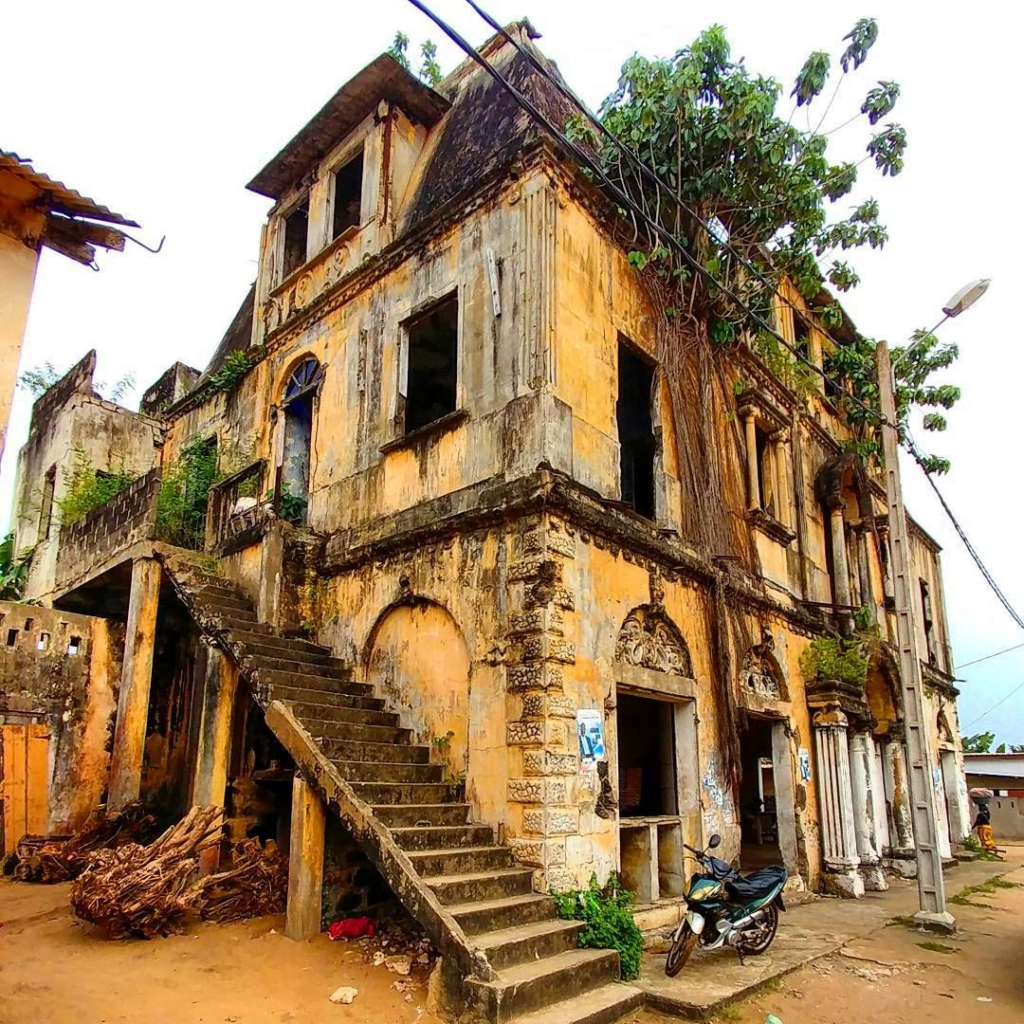




Ivory Coast flaunts more Unesco World Heritage Sites – the historic town of Grand-Bassam, Comoe National Park, numerou mosques and Tai National Park, hosting 11 monkey species.
Life Expectancy Insight!
Unfortunately, life expectancy in Ivory Coast is relatively low at 53.3 years, ranking fifth lowest in the world. However, efforts are underway to improve healthcare and well-being.
The Ivory Coast is the Cocoa Capital of the World!

Ivory Coast leads the world in cocoa production, contributing a whopping 31.6% of global cocoa beans in 2013 – that’s 1.448 million metric tonnes!
The Ivory Coast has Double Capitals Drama!
Ivory Coast likes to keep it interesting with two capitals – Yamoussoukro (political) and Abidjan (economic and largest city). That’s double the administrative charm!
French Influence in Abidjan!
Abidjan is the city with the world’s third-largest French-speaking population and stands as the fourth most populous city in Africa, with approximately 4.7 million residents.
St. Paul’s Glory!
Marvel at St. Paul’s Cathedral in Abidjan, a masterpiece built at a jaw-dropping cost of $12 million – Ivory Coast’s very own St. Paul’s!
Ivorian Cuisine – Great Recipes to Try at Home
Ivorian cuisine is a delightful adventure for the palate, with each dish offering a glimpse into the nation’s culture and traditions. The typical Ivorian meal is hearty, flavored with spices and aromatics, and centered around a starch base with a savory sauce or stew.
Ivory Coast Food – Attiéké (Fermented Cassava Couscous)

History and Background of Attiéké (Fermented Cassava Couscous) from Ivory Coast:
Attiéké is a traditional Ivorian dish with roots dating back centuries. Originating from the Ivory Coast in West Africa, Attiéké is a staple food in the region. Cassava, the main ingredient, is a starchy root vegetable widely cultivated in Ivory Coast.
The dish reflects the rich culinary heritage of the country and showcases the importance of cassava in Ivorian cuisine. Attiéké is known for its unique texture, tangy flavor, and versatility in accompanying various dishes.
Ivory Coast Food – Attiéké Ingredients
- 2 cups attiéké (fermented cassava couscous)
- 1 cup boiling water
- 2 tablespoons vegetable oil
- 1 teaspoon salt
- 1 tablespoon lemon juice
- Fresh vegetables (tomatoes, onions, and bell peppers) for garnish
- Grilled fish or chicken for serving (optional)
Ivory Coast Food – Attiéké Recipe
Preparing Attiéké:
- Rinse Attiéké:
- Place attiéké in a large bowl and rinse it thoroughly with cold water to remove excess starch.
- Steam Attiéké:
- In a heatproof bowl, pour boiling water over attiéké until it is completely covered.
- Cover the bowl with a lid or plastic wrap and let it steam for about 10-15 minutes until it becomes fluffy.
Flavoring Attiéké:
- Fluffing Attiéké:
- Use a fork to gently fluff the attiéké, separating any clumps.
- Seasoning Attiéké:
- Add vegetable oil, salt, and lemon juice to the attiéké. Mix well to evenly distribute the flavors.
Serving Attiéké:
- Garnish:
- Top the attiéké with fresh vegetables like diced tomatoes, onions, and bell peppers for a colorful and flavorful touch.
- Optional Protein:
- Serve attiéké with grilled fish or chicken for a complete and satisfying meal.
Serving Information:
- Serving Size: 4 people
- Estimated Cooking Time: 20 minutes
- Calories: The total calorie count depends on specific brands and quantities of ingredients used. Please refer to the nutritional information on product labels for accurate details.
Ivory Coast Food – Foutou (Pounded Plantain or Yam)

History and Background of Foutou (Pounded Plantain or Yam) from Ivory Coast:
Foutou, a cherished dish in Ivory Coast, has deep roots in the country’s cultural and culinary traditions. Originating from the Akan people, Foutou is a starchy delight made from either plantains or yams.
This dish reflects the agricultural abundance of the region, where plantains and yams thrive. Foutou showcases the Ivorian commitment to utilizing locally grown ingredients to create a flavorful and hearty meal.
Its preparation involves pounding the chosen starchy base into a smooth, elastic consistency, resulting in a dish that is not only delicious but also a symbol of cultural identity.
Ivory Coast Food – Foutou Ingredients
- 4 ripe plantains OR 2 yams (peeled and cut into chunks)
- Water for boiling
- Salt to taste
Ivory Coast Food – Foutou Recipe
Boiling and Pounding Plantains or Yams:
- Boil Plantains or Yams:
- Place the peeled and cut plantains or yams in a large pot and cover them with water.
- Add a pinch of salt to the water and bring it to a boil. Cook until the plantains or yams are tender.
- Drain and Cool:
- Drain the boiled plantains or yams and let them cool for a few minutes until they are comfortable to handle.
Pounding and Shaping Foutou:
- Pound the Starchy Base:
- Using a mortar and pestle or a food processor, pound the plantains or yams until they form a smooth, elastic dough-like consistency.
- Shape Foutou:
- Wet your hands with water to prevent sticking, then shape the pounded plantains or yams into smooth, round balls or cylindrical shapes.
Serving Foutou:
- Serve Warm:
- Foutou is traditionally served warm. It can be enjoyed with a variety of savory sauces, stews, or soups.
Serving Information:
- Serving Size: 4 people
- Estimated Cooking Time: 30 minutes
- Calories: The total calorie count depends on the quantity and type of plantains or yams used. Please refer to nutritional information on product labels for accurate details.
Ivory Coast Food – Placali (Fermented Cassava Dough)

History and Background of Placali (Fermented Cassava Dough) from Ivory Coast:
Placali, a traditional Ivorian dish, traces its origins to the rich cultural tapestry of the Ivory Coast. Rooted in the diverse culinary heritage of the Akan people, Placali is a unique preparation of fermented cassava dough.
Cassava, a staple crop in the region, undergoes a fermentation process, giving rise to the distinctive taste and texture of Placali. This dish not only reflects the resourcefulness of Ivorian cuisine but also serves as a testament to the cultural significance of cassava in the daily lives of the people.
Placali is often enjoyed alongside various sauces, soups, or stews, making it an integral part of Ivorian meals.
Ivory Coast Food – Placali Ingredients
- 2 cups cassava flour
- Water for mixing
- Banana leaves or plastic wrap for wrapping
- Salt to taste
Ivory Coast Food – Placali Recipe
Preparing Placali Dough:
- Combine Cassava Flour and Water:
- In a large bowl, mix the cassava flour with water, gradually adding water until a thick, smooth consistency is achieved.
- Ferment the Dough:
- Cover the bowl with a clean cloth and let the cassava dough ferment for 2-3 days. Stir occasionally to aid the fermentation process.
Shaping and Cooking Placali:
- Prepare Banana Leaves (if using):
- If using banana leaves, heat them over an open flame briefly to make them pliable. Cut them into squares for wrapping the Placali.
- Shape Placali:
- Wet your hands and shape the fermented cassava dough into small, round or cylindrical portions.
- Wrap in Banana Leaves (or Plastic Wrap):
- Place each portion of Placali on a square of banana leaf or plastic wrap. Fold and secure the leaves or wrap to enclose the dough.
- Steam Placali:
- Steam the wrapped Placali for about 30-40 minutes until it becomes firm and thoroughly cooked.
Serving Placali:
- Unwrap and Serve:
- Unwrap the Placali and serve it warm. It pairs well with various Ivorian sauces, soups, or stews.
Serving Information:
- Serving Size: 4 people
- Estimated Cooking Time: 3 days (including fermentation and preparation), 40 minutes (steaming)
- Calories: The total calorie count depends on the specific brand and quantity of cassava flour used. Please refer to nutritional information on product labels for accurate details.
Ivory Coast Food – Garba (Attiéké with Fried Tuna)

History and Background of Garba (Attiéké with Fried Tuna) from Ivory Coast:
Garba is a flavorful Ivorian dish that combines the unique texture of attiéké with the savory goodness of fried tuna. Originating from the coastal region of the Ivory Coast, Garba is a testament to the nation’s diverse culinary influences.
Attiéké, a fermented cassava couscous, serves as the base for this dish, reflecting the importance of cassava in Ivorian cuisine. The addition of fried tuna not only adds a delicious protein element but also highlights the coastal influence on the country’s food culture.
Garba is a beloved dish that beautifully blends tradition and innovation in Ivory Coast’s vibrant culinary landscape.
Ingredients:
- 2 cups attiéké (fermented cassava couscous)
- 1 cup boiling water
- 1 lb tuna steaks
- 2 tablespoons vegetable oil
- 1 onion, finely chopped
- 2 tomatoes, diced
- 1 bell pepper, sliced
- 2 cloves garlic, minced
- 1 teaspoon ground ginger
- Salt and pepper to taste
- Fresh cilantro for garnish
Recipe:
Preparing Attiéké:
- Rinse and Steam Attiéké:
- Rinse attiéké thoroughly and steam it by pouring boiling water over it. Let it sit covered for 10-15 minutes until fluffy.
- Fluff and Season Attiéké:
- Fluff the attiéké with a fork and season it with salt and a drizzle of vegetable oil. Set aside.
Frying Tuna:
- Season Tuna:
- Season tuna steaks with ground ginger, salt, and pepper.
- Fry Tuna:
- In a pan, heat vegetable oil and fry the seasoned tuna steaks until they are golden brown on both sides. Remove and set aside.
Sautéing Vegetables:
- Sauté Aromatics:
- In the same pan, sauté chopped onion, minced garlic, and sliced bell pepper until they are tender.
- Add Tomatoes:
- Add diced tomatoes to the pan and cook until they soften and release their juices.
Assembling Garba:
- Combine Ingredients:
- Mix the sautéed vegetables with the seasoned attiéké, breaking the tuna into chunks and adding it to the mixture.
- Garnish and Serve:
- Garnish with fresh cilantro and serve Garba warm. Enjoy the blend of textures and flavors!
Serving Information:
- Serving Size: 4 people
- Estimated Cooking Time: 30 minutes
- Calories: The total calorie count depends on the specific brands and quantities of ingredients used. Please refer to the nutritional information on product labels for accurate details.
Ivory Coast Food – Mafe (Peanut Butter Stew)

History and Background of Mafe (Peanut Butter Stew) from Ivory Coast:
Mafe, a delectable dish hailing from the Ivory Coast, holds its roots in the diverse culinary traditions of West Africa. Commonly known as groundnut stew or peanut butter stew, Mafe is a savory and rich delicacy enjoyed across the region.
Its origins can be traced to the Malinke people, who have contributed significantly to the cultural and gastronomic diversity of the Ivory Coast. Mafe exemplifies the ingenious use of peanuts, a widely cultivated crop in the region, creating a creamy and flavorful stew that has become a beloved staple in Ivorian households.
Ivory Coast Food – Mafe Ingredients
- 1 ½ lbs chicken, cut into pieces
- 1 cup peanut butter
- 2 tablespoons vegetable oil
- 1 large onion, finely chopped
- 3 tomatoes, diced
- 1 eggplant, diced
- 2 carrots, sliced
- 2 cups okra, sliced
- 3 cups chicken broth
- 2 tablespoons tomato paste
- 2 teaspoons ground cayenne pepper (adjust to taste)
- Salt and pepper to taste
Ivory Coast Food – Mafe Recipe
Preparing the Chicken:
- Sear Chicken:
- In a large pot, heat vegetable oil and sear the chicken pieces until they are browned on all sides.
- Sauté Onion and Tomatoes:
- Add chopped onion to the pot and sauté until it becomes translucent. Stir in diced tomatoes and cook until they soften.
Creating the Mafe Base:
- Add Peanut Butter and Tomato Paste:
- Mix peanut butter and tomato paste into the pot, stirring well to create a smooth base.
- Pour Chicken Broth:
- Gradually pour chicken broth into the pot, ensuring the ingredients are well combined.
Cooking Vegetables and Chicken:
- Incorporate Vegetables:
- Add diced eggplant, sliced carrots, and okra to the pot. Stir to combine.
- Season and Simmer:
- Season the stew with ground cayenne pepper, salt, and pepper. Allow it to simmer on low heat until the chicken is tender and the vegetables are cooked through.
Serving Mafe:
- Serve Warm:
- Mafe is best served warm. Enjoy it over rice or with a side of crusty bread.
Serving Information:
- Serving Size: 6 people
- Estimated Cooking Time: 1 hour
- Calories: The total calorie count depends on the specific brands and quantities of ingredients used. Please refer to the nutritional information on product labels for accurate details.
Ivory Coast Food – Poisson Braisé

History and Background of Poisson Braisé from Ivory Coast:
Poisson Braisé, a cherished dish in Ivory Coast, has deep roots in the country’s coastal culinary traditions. Directly translating to “grilled fish,” Poisson Braisé highlights the significance of fresh seafood in the region.
The Ivory Coast, with its extensive coastline along the Atlantic Ocean, is blessed with a wealth of marine resources. Poisson Braisé reflects the Ivorian love for bold flavors and simple yet exquisite preparation methods.
Often enjoyed in social gatherings and family feasts, this dish embodies the coastal charm and rich food culture of Ivory Coast.
Ivory Coast Food – Poisson Braisé Ingredients
- 2 lbs whole fish (such as tilapia or sea bass), cleaned and scaled
- 2 tablespoons vegetable oil
- 2 cloves garlic, minced
- 1 onion, finely chopped
- 2 tomatoes, diced
- 1 red bell pepper, sliced
- 1 green bell pepper, sliced
- 1 teaspoon ground cayenne pepper
- 1 teaspoon paprika
- Salt and pepper to taste
- Fresh parsley for garnish
Ivory Coast Food – Poisson Braisé Recipe
Preparing the Fish:
- Clean and Score Fish:
- Clean the whole fish, removing scales and internal organs. Score both sides with diagonal cuts.
- Marinate Fish:
- In a bowl, combine minced garlic, diced tomatoes, chopped onion, sliced red and green bell peppers, ground cayenne pepper, paprika, salt, and pepper. Mix well.
- Coat Fish:
- Rub the fish with vegetable oil, ensuring it’s well-coated. Stuff the fish cavity with the prepared vegetable mixture.
Grilling Poisson Braisé:
- Preheat Grill:
- Preheat a grill or barbecue to medium-high heat.
- Grill Fish:
- Place the marinated fish on the grill, cooking for approximately 15-20 minutes per side or until the fish is cooked through and has a delicious smoky flavor.
Serving Poisson Braisé:
- Garnish and Serve:
- Sprinkle fresh parsley over the grilled fish before serving. Poisson Braisé pairs well with a side of attiéké, rice, or plantains.
Serving Information:
- Serving Size: 4 people
- Estimated Cooking Time: 40 minutes
- Calories: The total calorie count depends on the specific type and size of the fish used. Please refer to nutritional information on product labels for accurate details.
Ivory Coast Food – Poulet Piquet

History and Background of Poulet Piquet from Ivory Coast:
Poulet Piquet, a flavorful dish from the Ivory Coast, showcases the country’s vibrant culinary tapestry. Directly translating to “spiced chicken,” Poulet Piquet reflects the Ivorian love for bold and aromatic flavors.
Rooted in the diverse cultural influences of the region, this dish has become a symbol of communal gatherings and celebrations.
The country’s ‘s unique blend of indigenous ingredients and culinary techniques has given rise to Poulet Piquet’s popularity, making it a staple on family tables and festive occasions.
Ivory Coast Food – Poulet Piquet Ingredients
- 2 lbs chicken pieces (drumsticks, thighs, or a combination)
- 2 tablespoons vegetable oil
- 1 onion, finely chopped
- 2 tomatoes, diced
- 2 bell peppers (red and green), sliced
- 2 cloves garlic, minced
- 1 teaspoon ground ginger
- 1 teaspoon ground cayenne pepper (adjust to taste)
- 1 teaspoon paprika
- 1 teaspoon thyme
- Salt and pepper to taste
- Fresh cilantro for garnish
Ivory Coast Food – Poulet Piquet Recipe
Preparing the Chicken:
- Clean and Pat Dry Chicken:
- Clean the chicken pieces and pat them dry with paper towels.
- Marinate Chicken:
- In a bowl, combine minced garlic, ground ginger, ground cayenne pepper, paprika, thyme, salt, and pepper. Rub the chicken pieces with this mixture, ensuring they are well-coated. Let it marinate for at least 30 minutes.
Cooking Poulet Piquet:
- Sauté Aromatics:
- In a large skillet or pot, heat vegetable oil over medium heat. Sauté chopped onions until they are translucent.
- Add Chicken:
- Add the marinated chicken pieces to the skillet and brown them on all sides.
- Incorporate Vegetables:
- Stir in diced tomatoes and sliced bell peppers, cooking until the vegetables are softened.
- Simmer:
- Pour a cup of water into the skillet, cover, and let the chicken simmer until it’s fully cooked and the flavors meld together.
Serving Poulet Piquet:
- Garnish and Serve:
- Garnish Poulet Piquet with fresh cilantro before serving. This dish pairs well with rice, attiéké, or a side of plantains.
Serving Information:
- Serving Size: 4 people
- Estimated Cooking Time: 45 minutes
- Calories: The total calorie count depends on the specific cuts of chicken used. Please refer to nutritional information on product labels for accurate details.
Ivory Coast Food – Choukouya

History and Background of Choukouya from Ivory Coast:
Choukouya, a delightful dish from the Ivory Coast, reflects the country’s rich culinary heritage and the influence of diverse flavors. Originating in the vibrant streets of Abidjan, Choukouya is a popular street food that has found its way into the hearts and homes of Ivorian households.
This grilled meat dish showcases the Ivorian passion for communal dining and bold, spicy flavors. The preparation of Choukouya has become an art, combining local spices and grilling techniques to create a savory and aromatic experience that embodies the essence of Ivory Coast’s food culture.
Ivory Coast Food – Choukouya Ingredients
- 2 lbs beef or chicken, cut into skewer-friendly pieces
- 1 cup vegetable oil
- 1 onion, finely chopped
- 3 cloves garlic, minced
- 1 teaspoon ginger, grated
- 2 teaspoons ground cayenne pepper (adjust to taste)
- 1 teaspoon paprika
- 1 teaspoon thyme
- Salt and pepper to taste
- Lime wedges for serving
Ivory Coast Food – Choukouya Recipe
Marinating the Meat:
- Prepare Meat Skewers:
- Thread the beef or chicken pieces onto skewers for grilling.
- Mix Spices:
- In a bowl, combine chopped onions, minced garlic, grated ginger, ground cayenne pepper, paprika, thyme, salt, and pepper. This mixture will serve as the flavorful marinade.
- Marinate the Meat:
- Brush the meat skewers with vegetable oil and generously coat them with the spice mixture. Let the meat marinate for at least 1 hour, allowing the flavors to infuse.
Grilling Choukouya:
- Preheat Grill:
- Preheat a grill or barbecue to medium-high heat.
- Grill Meat Skewers:
- Grill the marinated meat skewers, turning occasionally, until they are cooked to your desired level of doneness and have a delicious char.
Serving Choukouya:
- Garnish and Serve:
- Remove the skewers from the grill and squeeze lime wedges over the Choukouya for a burst of freshness. Serve hot, and enjoy the flavorful taste of Ivory Coast street food.
Serving Information:
- Serving Size: 4 people
- Estimated Cooking Time: 20 minutes (plus marinating time)
- Calories: The total calorie count depends on the type of meat used and specific cuts. Please refer to nutritional information on product labels for accurate details.
Ivory Coast Food – Soupe du Pêcheur (Fisherman’s Soup)

History and Background of Soupe du Pêcheur (Fisherman’s Soup) from Ivory Coast:
Soupe du Pêcheur, or Fisherman’s Soup, is a culinary delight that originates from the coastal regions of the Ivory Coast. As its name suggests, this dish is deeply intertwined with the local fishing culture. Ivory Coast’s Atlantic coastline provides an abundance of fresh seafood, influencing the creation of Soupe du Pêcheur.
With a history steeped in coastal traditions, this hearty soup captures the essence of the region, celebrating the bounty of the ocean and the ingenuity of Ivorian cuisine.
Ivory Coast Food – Soupe du Pêcheur Ingredients
- 1 lb mixed seafood (shrimp, fish fillets, mussels, etc.)
- 2 tablespoons vegetable oil
- 1 onion, finely chopped
- 2 tomatoes, diced
- 1 bell pepper, sliced
- 2 cloves garlic, minced
- 1 teaspoon ground cayenne pepper (adjust to taste)
- 1 teaspoon paprika
- 1 teaspoon thyme
- 4 cups fish or seafood broth
- Salt and pepper to taste
- Fresh parsley for garnish
Ivory Coast Food – Soupe du Pêcheur Recipe
Preparing the Seafood:
- Clean and Prepare Seafood:
- Clean and devein shrimp, cut fish fillets into bite-sized pieces, and scrub mussels. Set aside.
Cooking the Base:
- Sauté Aromatics:
- In a large pot, heat vegetable oil over medium heat. Sauté chopped onions, sliced bell pepper, and minced garlic until they are softened.
- Add Tomatoes and Spices:
- Stir in diced tomatoes, ground cayenne pepper, paprika, and thyme. Cook until the tomatoes break down and the spices are aromatic.
Building the Soup:
- Pour Broth:
- Add fish or seafood broth to the pot, bringing the mixture to a gentle simmer.
- Incorporate Seafood:
- Carefully add the prepared seafood to the simmering broth, ensuring even cooking.
- Season and Simmer:
- Season the soup with salt and pepper to taste. Allow the seafood to simmer until fully cooked.
Serving Soupe du Pêcheur:
- Garnish and Serve:
- Garnish the Fisherman’s Soup with fresh parsley before serving. Enjoy this flavorful and nourishing dish with a side of crusty bread.
Serving Information:
- Serving Size: 4 people
- Estimated Cooking Time: 30 minutes
- Calories: The total calorie count depends on the specific types and quantities of seafood used. Please refer to nutritional information on product labels for accurate details.
Ivory Coast Food – Poisson En Papillote (Fish Baked In Parchment Packets)

History and Background of Poisson En Papillote (Fish Baked In Parchment Packets) from Ivory Coast:
Poisson En Papillote, a delightful dish from the Ivory Coast, showcases the artistry of Ivorian culinary traditions. The method of cooking fish in parchment packets, also known as “en papillote,” has its roots in French cuisine but has been embraced and adapted by Ivory Coast, adding a touch of elegance to local flavors.
This cooking technique involves sealing the fish and flavorful ingredients in parchment paper, allowing them to steam and infuse with one another’s tastes. Poisson En Papillote captures the essence of Ivorian coastal cuisine, highlighting the bounty of the Atlantic Ocean and the creativity of local cooking.
Ivory Coast Food – Poisson En Papillote Ingredients
- 4 fish fillets (tilapia or sea bass work well)
- 2 tablespoons vegetable oil
- 1 onion, thinly sliced
- 2 tomatoes, thinly sliced
- 1 bell pepper, thinly sliced
- 2 cloves garlic, minced
- 1 teaspoon ground cayenne pepper (adjust to taste)
- 1 teaspoon paprika
- 1 teaspoon thyme
- Salt and pepper to taste
- Fresh herbs (such as parsley or cilantro) for garnish
Ivory Coast Food – Poisson En Papillote Recipe
Preparing the Fish:
- Season Fish Fillets:
- Season the fish fillets with salt, pepper, and a drizzle of vegetable oil. Set aside.
Creating Parchment Packets:
- Preheat Oven:
- Preheat the oven to 400°F (200°C).
- Prepare Parchment Paper:
- Cut four large squares of parchment paper.
- Assemble Ingredients:
- Place a fish fillet in the center of each parchment square. Top with sliced onions, tomatoes, bell peppers, minced garlic, ground cayenne pepper, paprika, thyme, and additional salt and pepper.
- Fold and Seal Packets:
- Fold the parchment paper over the fish and ingredients, sealing the edges to create a well-sealed packet.
Baking Poisson En Papillote:
- Place Packets on Baking Sheet:
- Arrange the sealed packets on a baking sheet.
- Bake in Oven:
- Bake in the preheated oven for approximately 15-20 minutes, allowing the fish to steam inside the packets until it is fully cooked and infused with the flavors of the vegetables and spices.
Serving Poisson En Papillote:
- Garnish and Serve:
- Carefully open the parchment packets, garnish the fish with fresh herbs, and serve immediately. Enjoy this delightful and aromatic dish.
Serving Information:
- Serving Size: 4 people
- Estimated Cooking Time: 20 minutes
- Calories: The total calorie count depends on the specific type and size of fish used. Please refer to nutritional information on product labels for accurate details.
Ivory Coast Food – Pain Brochette

History and Background of Pain Brochette from Ivory Coast:
Pain Brochette is a delightful dish hailing from the Ivory Coast, a country located on the West African coast. This savory recipe has deep roots in the region’s culinary traditions, reflecting the rich cultural tapestry of Ivory Coast.
The dish showcases a harmonious blend of indigenous ingredients, spices, and cooking techniques, making it a staple in Ivorian cuisine.
Ivory Coast Food – Pain Brochette Ingredients
- 2 lbs (about 1 kg) boneless chicken, cut into bite-sized pieces
- 1 cup peanut butter
- 2 tablespoons vegetable oil
- 2 tablespoons soy sauce
- 1 tablespoon tomato paste
- 1 teaspoon ground ginger
- 1 teaspoon garlic powder
- 1 teaspoon onion powder
- Salt and pepper to taste
- Wooden skewers, soaked in water
Ivory Coast Food – Pain Brochette Recipe
Preparing Ingredients:
- Marinating the Chicken:
- In a bowl, combine chicken pieces, soy sauce, ground ginger, garlic powder, onion powder, salt, and pepper.
- Allow the chicken to marinate for at least 30 minutes to absorb the flavors.
- Making the Peanut Sauce:
- In a saucepan, heat vegetable oil over medium heat.
- Add peanut butter and tomato paste, stirring continuously until well combined.
- Cook for 5-7 minutes, allowing the sauce to thicken. Set aside.
Assembling and Cooking:
- Skewering the Chicken:
- Thread the marinated chicken pieces onto the soaked wooden skewers.
- Grilling the Pain Brochette:
- Preheat the grill to medium-high heat.
- Grill the skewered chicken for about 10-15 minutes, turning occasionally until fully cooked and slightly charred.
- Serving:
- Serve the Pain Brochette hot off the grill with the prepared peanut sauce on the side.
Serving Information:
- Serves: 4-6 people
- Cooking Time: Approximately 45 minutes (including marination and grilling)
Nutritional Information (Approximate):
- Calories: 320 calories per serving (calculated based on a serving size of 1/6 of the recipe)
Ivory Coast Food – Akpessi (Fish And Eggplant Stew)

History and Background of Akpessi (Fish and Eggplant Stew) from Ivory Coast:
Akpessi, a flavorsome Fish and Eggplant Stew, originates from the Ivory Coast, a country in West Africa known for its diverse culinary traditions. This dish reflects the region’s reliance on fresh seafood and locally grown vegetables.
Akpessi stands as a testament to the Ivorian people’s culinary ingenuity, combining rich flavors and unique ingredients in a delightful stew.
Ivory Coast Food – Akpessi Ingredients
- 1 lb (about 450g) white fish fillets, cut into chunks
- 2 medium-sized eggplants, diced
- 1 onion, finely chopped
- 2 tomatoes, diced
- 2 bell peppers (preferably red or green), diced
- 3 cloves garlic, minced
- 1-inch ginger, grated
- 1 cup fish or vegetable broth
- 1/4 cup palm oil
- 2 tablespoons tomato paste
- 1 tablespoon ground crayfish (or substitute with shrimp paste)
- Salt and pepper to taste
- Fresh cilantro or parsley for garnish
Ivory Coast Food – Akpessi Recipe
Preparing Ingredients:
- Marinating the Fish:
- In a bowl, season the fish chunks with salt, pepper, and half of the minced garlic. Let it marinate for about 15 minutes.
- Prepping the Vegetables:
- Dice the eggplants, onions, tomatoes, and bell peppers.
Cooking Akpessi:
- Sautéing Aromatics:
- In a large pot, heat palm oil over medium heat.
- Sauté the remaining garlic, grated ginger, and chopped onions until fragrant.
- Adding Vegetables and Fish:
- Add diced tomatoes, bell peppers, and marinated fish to the pot.
- Cook for 5 minutes until the vegetables soften and the fish begins to brown.
- Creating the Stew Base:
- Stir in tomato paste and ground crayfish, ensuring even distribution.
- Pour in fish or vegetable broth, and let the stew simmer for 15-20 minutes.
- Incorporating Eggplants:
- Add diced eggplants to the stew and continue cooking until they are tender but not mushy.
- Adjusting Seasoning and Serving:
- Season the stew with salt and pepper according to taste.
- Garnish with fresh cilantro or parsley before serving.
Serving Information:
- Serves: 4-6 people
- Cooking Time: Approximately 45-60 minutes
Nutritional Information (Approximate):
- Calories: 280 calories per serving (calculated based on a serving size of 1/6 of the recipe)
Ivory Coast Food – Merveilles (Orange-Scented Cookies)

History and Background of Merveilles (Orange-Scented Cookies) from Ivory Coast:
Merveilles, the delightful Orange-Scented Cookies, hail from the Ivory Coast, a country rich in cultural diversity and vibrant culinary traditions. These cookies are a sweet reflection of Ivorian cuisine, combining locally available ingredients with a touch of citrusy zest.
Merveilles are not just treats; they are a connection to the warmth and hospitality embedded in the Ivory Coast’s food culture.
Ivory Coast Food – Merveilles Ingredients
- 2 cups all-purpose flour
- 1/2 cup granulated sugar
- 1/2 cup unsalted butter, softened
- 2 large eggs
- Zest of 2 oranges
- 1 teaspoon baking powder
- 1/4 teaspoon salt
- 1 teaspoon vanilla extract
- Powdered sugar for dusting
Ivory Coast Food – Merveilles Recipe
Preparing Ingredients:
- Zesting Oranges:
- Grate the zest of two oranges, making sure to avoid the bitter white pith.
Making Merveilles Cookies:
- Mixing the Dough:
- In a large bowl, cream together softened butter and granulated sugar until smooth.
- Add eggs one at a time, beating well after each addition.
- Stir in orange zest and vanilla extract.
- Combining Dry Ingredients:
- In a separate bowl, whisk together all-purpose flour, baking powder, and salt.
- Gradually add the dry ingredients to the wet ingredients, mixing until a soft dough forms.
- Chilling the Dough:
- Wrap the dough in plastic wrap and refrigerate for at least 30 minutes to firm it up.
- Shaping the Cookies:
- Preheat the oven to 350°F (180°C).
- Take small portions of the chilled dough and roll them into balls or other desired shapes.
- Baking Merveilles:
- Place the shaped cookies on a parchment-lined baking sheet.
- Bake for 12-15 minutes or until the edges turn golden brown.
- Dusting with Powdered Sugar:
- Allow the cookies to cool completely on a wire rack.
- Dust with powdered sugar before serving.
Serving Information:
- Serves: Approximately 24 cookies
- Cooking Time: Approximately 45 minutes (including chilling time)
Nutritional Information (Approximate):
- Calories: 120 calories per serving (calculated based on a serving size of 2 cookies)
Ivory Coast Food – Gbofloto (Sweet Fritters)

History and Background of Gbofloto (Sweet Fritters) from Ivory Coast:
Gbofloto, the delightful Sweet Fritters, are a popular treat originating from the Ivory Coast, a country nestled in West Africa. These golden, crispy fritters hold a special place in Ivorian culture, often enjoyed during festive occasions and celebrations.
The recipe reflects the region’s love for simple yet flavorful snacks that bring joy to gatherings and showcase the warmth of Ivorian hospitality.
Ivory Coast Food – Gbofloto Ingredients
- 2 cups all-purpose flour
- 1 cup cornmeal
- 1 cup granulated sugar
- 1 teaspoon baking powder
- 1/2 teaspoon nutmeg, freshly grated
- 1/4 teaspoon salt
- 2 ripe bananas, mashed
- 1 cup water
- Vegetable oil for frying
- Powdered sugar for dusting
Ivory Coast Food – Gbofloto Recipe
Preparing Ingredients:
- Mashing Bananas:
- Peel and mash the ripe bananas in a bowl, ensuring a smooth consistency.
Making Gbofloto Sweet Fritters:
- Combining Dry Ingredients:
- In a large mixing bowl, whisk together all-purpose flour, cornmeal, granulated sugar, baking powder, freshly grated nutmeg, and salt.
- Creating Batter:
- Add the mashed bananas to the dry ingredients.
- Gradually pour in water while stirring continuously to form a thick, smooth batter.
- Heating Oil:
- In a deep frying pan, heat vegetable oil to 350°F (180°C).
- Frying Gbofloto:
- Using a spoon or hands, drop small portions of the batter into the hot oil, ensuring not to overcrowd the pan.
- Fry until the fritters turn golden brown, flipping as needed for even cooking.
- Draining and Dusting:
- Remove the fried fritters using a slotted spoon, allowing excess oil to drain on a paper towel.
- Dust the Gbofloto with powdered sugar while they are still warm.
Serving Information:
- Serves: Approximately 6-8 people
- Cooking Time: Approximately 30 minutes
Nutritional Information (Approximate):
- Calories: 220 calories per serving (calculated based on a serving size of 4 fritters)
Ivory Coast Food – Banane Braisée (Grilled Bananas)

History and Background of Banane Braisée (Grilled Bananas) from Ivory Coast:
Banane Braisée, or Grilled Bananas, is a delightful and straightforward treat originating from the Ivory Coast in West Africa. In this region, bananas are not only enjoyed fresh but also take on a new dimension when grilled.
This culinary practice reflects the Ivorian love for simple yet flavorful snacks that highlight the natural sweetness of bananas. Banane Braisée is often enjoyed as a quick and satisfying street food or dessert option.
Ivory Coast Food – Banane Braisée Ingredients
- 4 ripe but firm bananas
- 2 tablespoons honey
- 1 tablespoon unsalted butter, melted
- 1/2 teaspoon ground cinnamon
- Pinch of salt
- Chopped nuts or shredded coconut for garnish (optional)
- Vanilla ice cream for serving (optional)
Ivory Coast Food – Banane Braisée Recipe
Preparing Ingredients:
- Preheating the Grill:
- Preheat an outdoor grill or stovetop grill pan to medium-high heat.
Making Banane Braisée (Grilled Bananas):
- Preparing Bananas:
- Peel the bananas and cut them in half lengthwise.
- Creating Glaze:
- In a small bowl, mix together honey, melted butter, ground cinnamon, and a pinch of salt.
- Coating Bananas:
- Brush the banana halves with the prepared glaze, ensuring they are well-coated.
- Grilling Bananas:
- Place the glazed bananas on the preheated grill and cook for 2-3 minutes per side or until grill marks appear and the bananas are heated through.
- Serving:
- Remove the grilled bananas from the heat and place them on a serving platter.
- Optionally, garnish with chopped nuts or shredded coconut.
- Serve Banane Braisée on its own or with a scoop of vanilla ice cream for an extra indulgence.
Serving Information:
- Serves: Approximately 4 people
- Cooking Time: Approximately 10 minutes
Nutritional Information (Approximate):
- Calories: 150 calories per serving (calculated based on one grilled banana half with glaze)
Ivorian cuisine – Alloco

Alloco is a beloved Ivorian snack that doubles as a starter. It’s a simple yet delicious dish made from ripe plantains.
Ingredients for Alloco
- Ripe plantains
- Palm oil or vegetable oil for frying
- Salt to taste
- Optional: diced onions and fresh chili for serving
How to prepare Alloco
- Peel the plantains and cut them into bite-size pieces.
- Heat oil in a deep fryer or a large pan to 350°F (175°C).
- Carefully add the plantain pieces to the hot oil and fry until they are golden brown and tender.
- Remove the plantains with a slotted spoon and drain on paper towels. Season with salt.
- Serve hot with optional onions and chili on the side.
Alloco is best presented in a casual manner, piled high on a serving platter, embodying the spirit of Ivorian street food. A cold beer or a sweet fruit juice complements the dish perfectly.
Ivorian Cuisine – Kachumbari

Kachumbari is an Ivorian version of a fresh tomato and onion salad, typically served as a refreshing starter or side dish.
Ingredients for Kachumbari
- Tomatoes, finely chopped
- Onions, thinly sliced
- Freshly squeezed lemon juice
- Salt and pepper to taste
- Chopped parsley or coriander (cilantro) for garnish
How to prepare Kachumbari
- In a mixing bowl, combine the chopped tomatoes and sliced onions.
- Drizzle with lemon juice, and season with salt and pepper.
- Toss everything together and let it marinate for about 10 minutes.
- Just before serving, garnish with chopped parsley or coriander.
Kachumbari is best served fresh and chilled, in a clear bowl to showcase its vibrant colors. It pairs wonderfully with a refreshing ginger beer or a crisp white wine.
Ivorian Cuisine – Attiéké au Poisson

This dish is a beloved staple in Ivorian cuisine, typically enjoyed for lunch or dinner. Attiéké, a couscous-like side made from cassava, pairs wonderfully with grilled or fried fish.
Ivorian Cuisine – Attiéké au Poisson Occasion
Attiéké au Poisson is often seen at festive gatherings and is a go-to meal for many on the weekends.
Ingredients for Attiéké au Poisson
- 500 grams of Attiéké (fermented cassava granules)
- 4 whole tilapia or other firm white fish, cleaned and scored
- 2 tomatoes, diced
- 1 onion, thinly sliced
- Fresh parsley, chopped
- 1 hot pepper, finely chopped (optional)
- 4 tablespoons of vegetable oil
- Lemon quarters, for serving
- Salt and pepper to taste
Attiéké au Poisson Recipe
- Start by preparing the Attiéké according to the package instructions. Typically, it involves steaming until it’s fluffy.
- Season the fish with salt and pepper. You can also add some lemon juice and let it marinate for a bit.
- Heat the oil in a grill pan or skillet and cook the fish over medium heat until golden brown and cooked through, about 5-7 minutes per side.
- For the sauce, combine the diced tomatoes, sliced onion, chopped parsley, and hot pepper if using. Season with salt and lemon juice.
- Serve the grilled fish hot with the Attiéké and top with the fresh tomato-onion sauce. Squeeze extra lemon juice over the fish if desired.
Ivorian Cuisine – Kedjenou de Poulet

Kedjenou is a spicy stew that showcases the Ivorian love for slow-cooking. Chicken is the star of this dish, simmered in its own juices with vegetables and spices until tender.
Ivorian Cuisine – Kedjenou de Poulet Occasion
Kedjenou de Poulet is a comfort food, often served at home for a family dinner.
Ingredients for Kedjenou de Poulet
- 1 whole chicken, cut into pieces
- 2 onions, chopped
- 4 tomatoes, chopped
- 1 eggplant, diced
- 2 carrots, sliced
- 1 bell pepper, chopped
- 3 cloves of garlic, minced
- A pinch of thyme
- 1 bay leaf
- 1 piece of ginger, grated
- Chili pepper to taste
- Salt and pepper to taste
Kedjenou de Poulet Recipe
- In a large pot or a traditional earthenware kedjenou pot, place the chicken pieces.
- Add all the chopped vegetables, garlic, and spices over the chicken.
- Seal the pot with its lid. Ivorians traditionally seal it with banana leaves to lock in the steam.
- Cook over low heat for about 1 to 2 hours. Resist the urge to add water; the chicken will cook in its own juices and those of the vegetables.
- Shake the pot occasionally to prevent sticking and to mix the ingredients without opening the lid.
- Once the chicken is tender and the vegetables are cooked down into a thick sauce, adjust the seasoning and serve with rice or Attiéké.
Ivorian Cuisine – Sauce Graine à la Viande
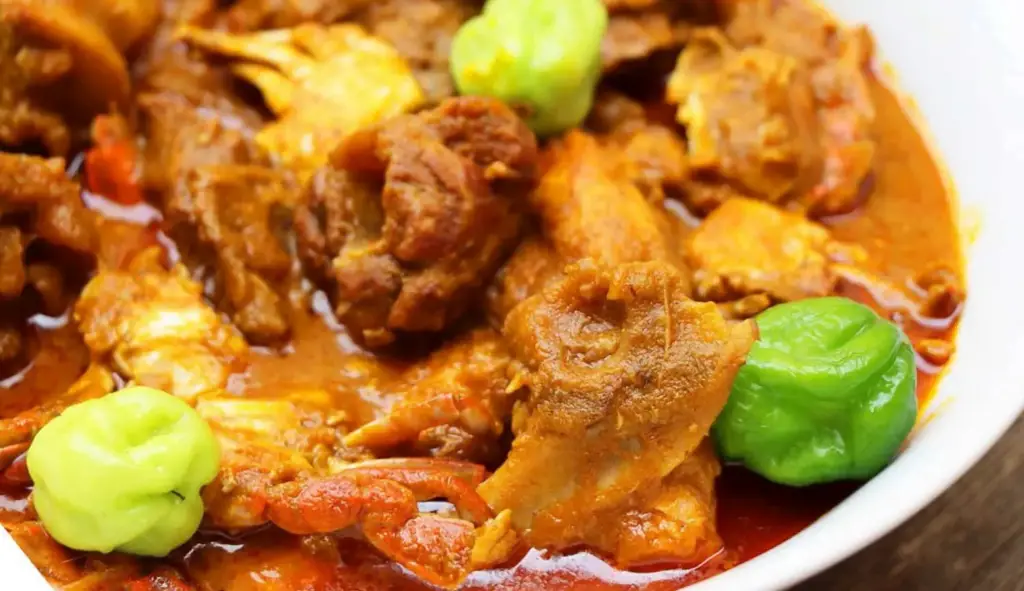
Sauce Graine, also known as Palm Nut Soup, is a hearty and creamy stew made from the pulp of palm nuts. It’s typically cooked with meat or fish and a variety of spices.
Sauce Graine à la Viande – Occasion
This dish is a Sunday lunch favorite and is also served during special occasions and celebrations.
Ingredients for Sauce Graine à la Viande
- 500 grams of meat (beef, goat, or chicken)
- 2 cups of palm nut cream concentrate
- 1 onion, diced
- 2 tomatoes, crushed
- 4 cups of chicken or beef stock
- 2 tablespoons of tomato paste
- 1 hot pepper (optional)
- 1 tablespoon of ginger paste
- 2 cloves of garlic, minced
- Salt and pepper to taste
- A handful of basil leaves
Sauce Graine à la Viande Recipe
- In a large pot, brown the meat with a little oil. Add the diced onion and cook until translucent.
- Stir in the crushed tomatoes, tomato paste, ginger paste, and minced garlic.
- Add the palm nut cream and stock, then bring to a boil.
- Reduce heat to a simmer, add the hot pepper if using, and let it cook for about an hour or until the meat is tender and the sauce has thickened.
- Season with salt, pepper, and add the basil leaves a few minutes before taking it off the heat.
- Serve the Sauce Graine over boiled yams, rice, or with Fufu (a doughy side made from boiled and pounded starchy vegetables).
Ivorian Cuisine – Dégué (Millet Pudding)
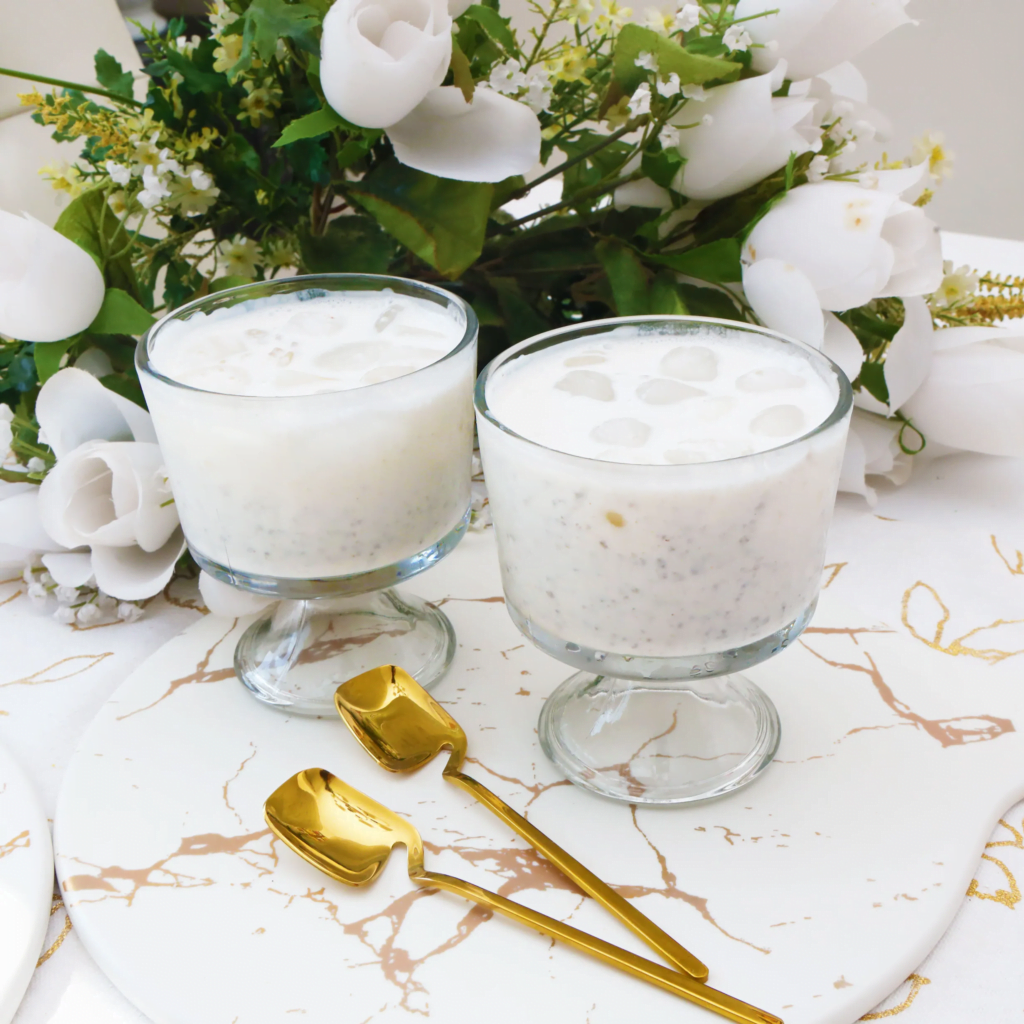
This is a refreshing pudding made from fermented millet or sorghum grains, often mixed with yogurt or milk.
Dégué (Millet Pudding) – Occasion
It’s a common snack or dessert, perfect for hot days or to enjoy at the end of a meal.
Ingredients for Dégué
- 2 cups of millet grains
- 4 cups of plain yogurt or sweetened condensed milk
- 1/2 cup of sugar (adjust to taste)
- 1 teaspoon of vanilla extract
- Grated nutmeg (optional)
Recipe for Dégué
- Rinse the millet grains and soak them overnight in water.
- Drain and let the grains ferment in a warm place for a few hours.
- Steam the fermented grains until they are tender, then let them cool.
- In a large bowl, mix the cooled grains with yogurt or sweetened condensed milk.
- Add sugar, vanilla extract, and grated nutmeg if desired. Mix well.
- Chill in the refrigerator before serving.
Ivorian Cuisine – Banane au Beurre (Baked Banana Pudding)

This simple yet satisfying dessert features bananas baked in a sauce of butter and sugar, often spiced with a touch of nutmeg or cinnamon.
Banane au Beurre – Occasion
Banane au Beurre is a cozy dessert, perfect for a family gathering or a quiet evening at home.
Ingredients for Banane au Beurre
- 4 ripe bananas
- 4 tablespoons of unsalted butter
- 4 tablespoons of brown sugar
- A pinch of ground nutmeg or cinnamon
Banane au Beurre Recipe
- Preheat the oven to 180°C (350°F).
- Peel the bananas and place them in a baking dish.
- Dot each banana with butter and sprinkle with brown sugar.
- Add a pinch of nutmeg or cinnamon over the bananas for extra flavor.
- Bake in the oven for about 15 minutes, or until the bananas are soft and the sugar has caramelized.
- Serve warm, possibly with a scoop of vanilla ice cream or a dollop of whipped cream.
Conclusion
Ivorian cuisine is a fascinating tapestry of flavors that reflects the rich cultural diversity of Côte d’Ivoire. From the ubiquitous Attiéké au Poisson to the savory Sauce Graine and the sweet satisfaction of Banane au Beurre, Ivorian dishes offer a taste experience that is both unique and delightful.
The main courses are a testament to the Ivorian art of cooking, balancing hearty ingredients with aromatic spices to produce meals that are both nutritious and comforting. Ivorian puddings, though simpler, are no less significant, presenting flavors and textures that are true to the region’s culinary philosophy.
This cuisine is a celebration of local produce and traditional cooking methods, and every dish tells a story of the Ivorian way of life.
FAQ’s
What is the staple food in Ivorian cuisine?
Ivorian cuisine is built around staples such as yams, cassava, plantains, and rice. These are often accompanied by a variety of sauces and stews, with Attiéké (fermented cassava granules) being particularly prominent.
Are Ivorian dishes very spicy?
The spice levels in Ivorian dishes can vary. Many traditional recipes incorporate chili peppers and ginger, which can be quite spicy. However, the heat is typically balanced with other flavors, and dishes can be adjusted to suit individual spice tolerances.
What meats are commonly used in Ivorian main courses?
Chicken, fish, goat, and beef are the most common meats featured in Ivorian main courses. These meats are often stewed or grilled and are incorporated into various dishes with rich, flavorful sauces.
Can Ivorian dishes be made vegetarian?
Yes, many Ivorian dishes can be adapted for a vegetarian diet. Stews and sauces can be made without meat, focusing instead on the rich variety of Ivorian vegetables, legumes, and grains.
What is a popular Ivorian dessert?
Dégué, a millet pudding mixed with yogurt or sweetened condensed milk, is a popular dessert in Côte d’Ivoire. It’s a simple, refreshing treat that can be flavored with vanilla or nutmeg.
How do I make Attiéké?
Attiéké is made from fermented cassava that has been grated and dried into fine granules. To prepare it, you typically steam the granules until they are fluffy. It’s a process that requires some patience but results in a delicious and versatile side dish that can be paired with meats, vegetables, or sauces.

